Posted on November 5, 2024 in ASRC News, Nanoscience Initiative

The breakthrough could advance efforts toward clean energy production
NEW YORK, November 5, 2024 — Scientists at the CUNY ASRC have developed a novel approach to better understand and predict the behaviors of water-responsive materials—solid matter that can change shape by absorbing or releasing water in response to humidity fluctuations. These materials, commonly found in Nature, have the potential to revolutionize a range of industries, from robotics and smart textiles to bioelectronics and clean energy generation systems.
Despite water-responsive materials’ growing popularity in research and development, a gap exists in the theoretical understanding of how these materials generate mechanical stress when they absorb and release water. A research team led by Professor Xi Chen at the CUNY ASRC Nanoscience Initiative and City College of New York’s Chemical Engineering Department has pioneered a new quantitative method to correlate the structure of confined water with the macroscopic water-responsive properties of materials like silk.
“Water-responsive materials that react to humidity changes are highly promising for use as actuators in robotics and for energy harvesting applications, yet we lack the theories to explain or predict the stress they generate,” said Chen.
“Our research shows that nanoconfinement of water plays a crucial role in determining the behavior of regenerated silk fibroin films. The important parameters highlighted in the study, will allow us to better predict material performance and engineering for future use in water-responsive actuators” said Darjan Podbevšek, the paper’s first author and a postdoctoral research associate in Chen’s and Raymond Tu’s labs. Tu is a co-corresponding author of the paper and a Chemical Engineering professor at CUNY’s City College of New York.
The study, published in Nature Communications, introduces a groundbreaking approach to explain water-responsive materials’ behavior, focusing on how water’s molecular structure within these materials affects stress generation. Previous studies have only qualitatively explained hydration and dehydration-induced stress in WR materials, but this new approach quantitatively demonstrates that the water structure, rather than the material’s structural properties, is the main factor governing stress.
The team discovered that all the samples began to exert force when they reached a critical threshold at which their bound and mobile water ratios reached a specific value, consistent to all samples. This finding highlights the importance of the different water populations in the biomaterials and suggests universal guidelines for predicting and engineering water-responsive behavior in biopolymers.
“This breakthrough not only helps us understand how water-responsive materials work, but also opens doors to exciting new applications in tissue engineering, biocompatible materials, optical coatings, and beyond,” said Tu.
The study, funded by the Air Force Office of Scientific Research and the National Science Foundation, provides key insights that could be applied to a wide range of hygroscopic and water-absorbent materials, with significant implications for industries like biomedical engineering, food preservation, and cosmetics.
About the Advanced Science Research Center at the CUNY Graduate Center
The Advanced Science Research Center at the CUNY Graduate Center (CUNY ASRC) is a world-leading center of scientific excellence that elevates STEM inquiry and education at CUNY and beyond. The CUNY ASRC’s research initiatives span five distinctive, but broadly interconnected disciplines: nanoscience, photonics, neuroscience, structural biology, and environmental sciences. The center promotes a collaborative, interdisciplinary research culture where renowned and emerging scientists advance their discoveries using state-of-the-art equipment and cutting-edge core facilities.
About the Graduate Center of The City University of New York
The CUNY Graduate Center is a leader in public graduate education devoted to enhancing the public good through pioneering research, serious learning, and reasoned debate. The Graduate Center offers ambitious students nearly 50 doctoral and master’s programs of the highest caliber, taught by top faculty from throughout CUNY — the nation’s largest urban public university. Through its nearly 40 centers, institutes, initiatives, and the Advanced Science Research Center, the Graduate Center influences public policy and discourse and shapes innovation. The Graduate Center’s extensive public programs make it a home for culture and conversation.
